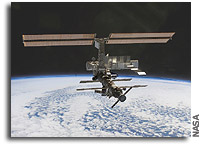First International Space Station Turns Two
 The “terrible twos” aren’t so terrible for the International Space Station.
The “terrible twos” aren’t so terrible for the International Space Station.
The world’s first international orbital outpost celebrates
the second anniversary of continuous residency and permanent
human presence in space Saturday, Nov. 2. The anniversary
marks an ambitious and virtually flawless year of expansion
and research in space.
Already the largest, most sophisticated and powerful
spacecraft ever built, when its second year of occupancy
began in 2001, the station has grown by more than 56,000
pounds in components added during the past 12 months. Over
the last two years, the station has grown by more than
200,000 pounds, and its internal volume has increased from
that of an efficiency apartment to a three-bedroom house.
This year, construction began on the station’s backbone, a
truss structure that eventually will support almost an acre
of solar panels to provide more power for orbital research
than ever before.
“The International Space Station was truly spectacular a year
ago, but with each new assembly mission — almost one every
month — it’s further enhanced,” said Bill Gerstenmaier,
International Space Station Program Manager, NASA Johnson
Space Center, Houston. “Our success in the past two years has
been phenomenal. We are blazing a trail in space and on
Earth, through research and international cooperation, which
can improve lives and expand exploration. We have many
challenges ahead, but this team’s continued hard work and
dedication will build a final facility that eclipses even
today’s station,” he said.
By the end of 2002, the station’s truss will stretch almost
133 feet. When completed in 2004, the truss will stretch 356
feet; longer than a football field. This year has seen
assembly of the first “space railroad,” including a mobile
base on the truss for the station’s Canadian robotic arm and
a “hand car” for spacewalkers.
As the station expands, so does its research capability.
Experiments aboard the complex have attained more than 90,000
hours of operating time. Sixty-five U.S. investigations have
been launched as well as numerous international studies.
An example of Station-based research recently involved the
first-ever soybean crop grown in space. After spending nearly
100 days aboard the Station and returning on a visiting Space
Shuttle, the seeds are undergoing several months of chemical
and biological tests on Earth to reveal whether their growth
in a low-gravity environment changed their chemical
composition.
Soybeans are a leading source of protein in the human diet
and are used in many products, from oil to crayons. Space
Station research, in conjunction with commercial companies,
in this area could lead to producing crops that support long-
term human presence in space and possibly pave the way for
improving crops grown on Earth.
In the past 12 months, 33 people have visited or lived aboard
the orbiting complex. A total of 112 visitors have been
aboard the station since it was launched, including men and
women from six nations. The first crewmembers docked with the
Station to begin its permanent occupancy on November 2, 2000.
Five three-person crews have lived aboard for durations
ranging from four to more than six months. In its second year
of occupancy, astronauts and cosmonauts have conducted 16
spacewalks for maintenance and assembly of the Station.
More information about the Station is available on the
Internet at:
http://spaceflight.nasa.gov








